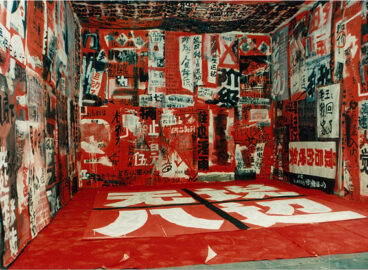「人人都有權利拒絕成為藝術家」—與吳山專對話
上海,2014年6月30日 與談人,編輯: 李雨潔 文稿整理: 陳聆 Read the English version here. 1993年的海外展覽—把給藝術的材料費放到銀行裡 李雨潔: 1988年的時候你就曾經有作品在漢堡展覽,這個是怎麼發生的? 吳山專: 我是1986年從浙江美院畢業的,畢業我就回到我的小島——舟山群島普陀山那裡。我們學校1984年以後一直有一個對外的交流項目,主要的還是跟美國明尼蘇達的,那偶然地也跟歐洲合作。1987年的時候,他們請到了一個德國的資本主義現實主義的人物K.P. Brehmer,他來學校給我們學生講西方藝術史。當時范小梅老師做接待,他打電話來舟山,說,這裡有個漢堡美術學院的,他對你東西感興趣,然後我就帶了一疊幻燈片,從舟山到杭州,見到K.P. Brehmer,他說他可以做一個展覽,這個後來實踐了。 李雨潔: 所以你本人沒去佈展? 吳山專: 沒有。展覽在漢堡紅燈區的Galerie Vorsetzen,這個時候K.P. Brehmer已經是這個畫廊的持股人,所以他才有一定的決定權,做一些中國當時的藝術。另外那時候中德也常有一些交流,在一個政治的平台上, 畫廊也會做一些關於中國的展覽,那麼我就變成了《 3 x China…》的其中一個參展藝術家。 李雨潔: 你參展的作品是什麼呢? 吳山專: 我不知道作品是怎樣呈現的,他看了一疊幻燈片,然後抽出五六張帶回德國去了。如果做一個展覽的話,我想,我的作品應該是以印出來的方式呈現。 李雨潔: 你93年參加了好多展覽,那包括了那些最大的在香港的《後89中國新藝術》,柏林的《中國前衛》,還有在俄亥俄大學Wexner Center的展覽,這些是比較大的群展。 吳山專: 對,這個時候中國當代藝術好像很熱門,每個人都做一點,丹麥做了一點嘛那麼英國也要做一點,德國也要做一點,整個歐洲的一些國家都要做一點,然後Wexner Center也要做一點嘛。但是都不是主流的博物館做的,蠻有意思的。 李雨潔: 你參加了這麼多在那一年的展覽, 都在不同的地方,作為一個當時所謂中國前衛藝術家的代表,你覺得每個機構說故事的方法有什麼不一樣? 吳山專: 他們最主要的一個態度:A Package。那麼其實藝術家也知道我們只是一整組其中的一個,是一個集合。他們說故事的方式其實完全一樣。造成參展人數不同的原因有很多,一個可能是資金問題,一個可能當時簽證也很難拿到。 李雨潔: 你本人去了哪裡佈展? 吳山專: 去了威尼斯,丹麥,荷蘭,美國。 李雨潔: 你第一次去威尼斯雙年展的感覺是什麼? 吳山專: 在第一屆的威尼斯可能作為組合中的一份子的感覺還少一點,我參加的是開放展 Aperto。93年威尼斯雙年展有兩個項目展出了中國藝術家的作品,一個Oliva (Achille Bonito Oliva) 組織的《東方之路》( Passaggio ad Oriente),另一個是《開放展》 (Aperto) 。開放展的那個策展團隊當中有孔長安,已經開始由他者來呈現,其實很了不起了,開放展大概有十個小的策展人, Oliva跟大家一起選。孔長安可以推薦三個,之後Oliva定,華人選了我,王友身,還有台灣來的李銘盛。 李雨潔: 你們三個是孔長安提進去的? 吳山專: 對,所以說跟東方之路是兩回事。Oliva還是有一點NGO的這種態度,這種包容力蠻不錯的。我的作品是《把給藝術的材料費放到銀行裡面》。當時運輸單位來拿作品,他說,我們到漢堡來取一件作品,名字叫做《把藝術的材料費放到銀行》,他以為是一個實體作品。其實那個作品是把威尼斯雙年展給我的錢放到銀行裡。 李雨潔: 他們真的去取了? 吳山專: 運輸公司是跟主委會是沒關係的嘛,運輸公司只是收到通知,漢堡有一件作品是《把給藝術的錢放到銀行》,但其實它是呈現藝術家跟社會的關係。就是說我在一個地方收到邀請,說是給我作藝術,給我材料費,結果我把材料費放到銀行裡,然後砸爛這個銀行的收據。那當然在93年來說的話,這個作品是非常傑出的,作者本人完全脫離了責任,同時這個行為又非常徹底。好比杜象也一直在逃離一種責任。我後來聽說,大概前前一屆的Documenta吧,有一個人做了一模一樣的作品:《把給藝術的錢放在銀行》,好幾個人告訴我這件事。我當年做的其實是三個方案中最後實行的一件,第一個是把展覽的空間租掉,第二件是把給藝術的材料費放到銀行裡, 第三件是就地打工以生存。所以說,從這三個方案,你就看到一個藝術家的生存問題多重要,這個藉口多麼地強大,以至於可以成為藝術品。 今天看來我還是很高興的,在93年的時候做成了這個三個方案。 李雨潔: 你怎麼呈現它們? 吳山專: 《把給藝術的材料費放到銀行》就是object…
